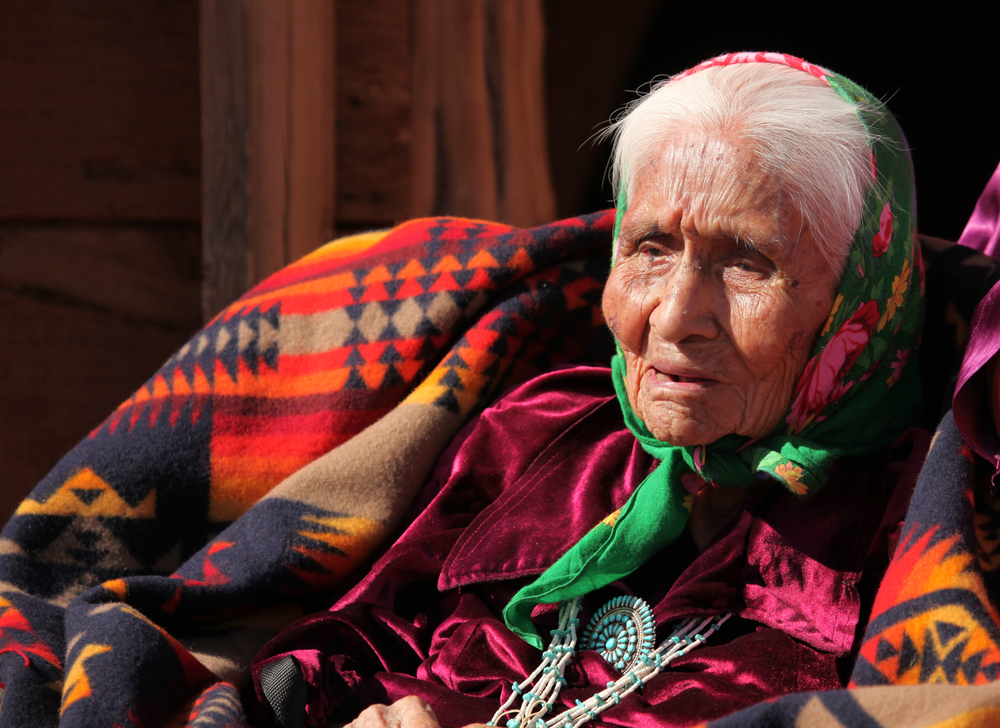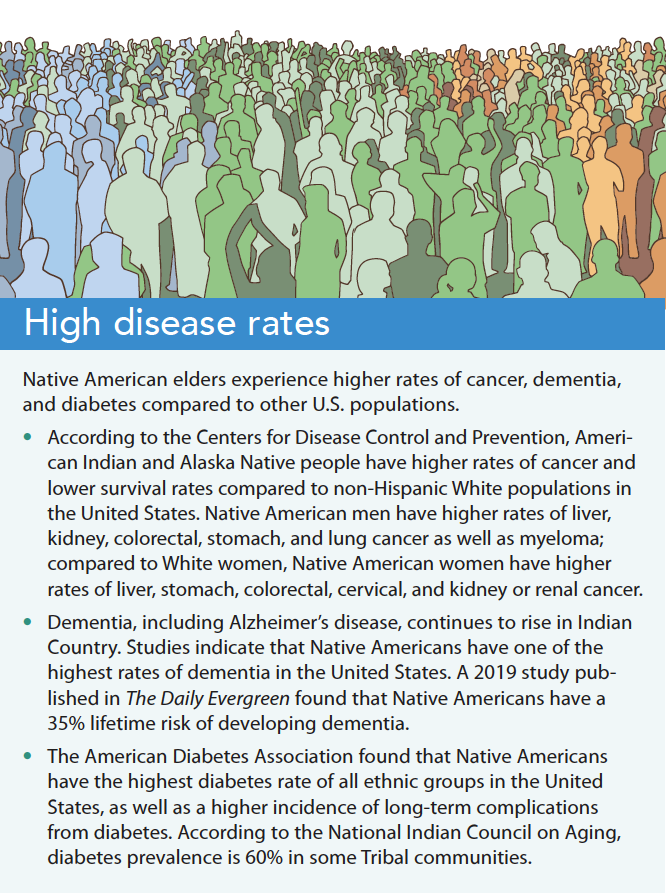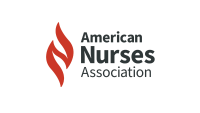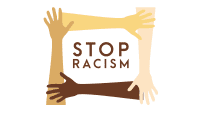Ask respectful questions, listen closely, show compassion.
- Four significant factors compromise care for Native American elders: healthcare disparities, historical trauma, healthcare shortages afflicting rural areas and reservations, and a lack of culturally appropriate care in long-term care facilities.
- Lack of services leads many Native American seniors to seek treatment from non-Tribal healthcare systems, where healthcare providers may lack an understanding of a patient’s cultural background.
- Native American elders deserve the same accessible resources and culturally sensitive care other American seniors take for granted.
Growing old in America can be frightening. Some retirees enjoy their golden years, but others struggle on fixed incomes and live below the poverty level. Some seniors can’t afford to retire at all, and some forego groceries to pay for medication. When an older adult can’t afford long-term care or a senior living facility, their caregivers quickly become overwhelmed. All of this holds true even for relatively privileged Americans, but aging proves even more difficult for Native American seniors, who frequently face pressing medical needs and reduced care options.
The population of Native seniors continues to increase. In the 1940s, according to the Indian Health Service, life expectancy in a Tribal community was 51 years. But Indigenous elders now live much longer, with Tribal nations expected to have 300,000 elders over the age of 85 by 2050—a sharp rise from 42,000 in 2012.
Reporting on racism in nursing
Nurse-led national commission examines racism in nursing
Making a difference for patients through culturally congruent care
Despite positive news for Native American communities, four significant factors compromise care for this new generation of elders: healthcare disparities, historical trauma, healthcare shortages afflicting rural areas and reservations, and a lack of culturally appropriate care in long-term care facilities.
Healthcare disparities
For centuries, Native American communities have faced widespread systemic challenges. Damaging governmental policies, generational poverty, chronic underfunding, and environmental pollution have created patterns of health disparities that aren’t easy to dismantle. Some of these challenges—high rates of cancer, dementia, and diabetes—hit seniors the hardest. (See High disease rates.)
Historical trauma
Today’s Indigenous elders carry a lifetime’s burden of systemic racism and cultural erasure. Many people associate discrimination and cruelty with the distant past, but abusive boarding schools were active as recently as the 1970s, and many elders living today are survivors. According to the National Native American Boarding School Healing Coalition (the Coalition), the schools deliberately severed children from ancestral practices and their Tribal communities. The children experienced physical abuse and deplorable conditions.
In the past 2 years, the Coalition and the U.S. Department of the Interior have focused on locating the remains of Indigenous children at these schools in Canada and the United States. Within the United States, the Coalition has catalogued more than 357 schools in 29 states. The schools cut the children’s hair, took away their clothes and belongings, changed their names, and refused them contact with their families. Malnourished, beaten, and sexually abused, many children died. Those who survived were scarred by neglect, violence, and the memories of burying their classmates in mass graves. Many survivors internalized a type of trauma that manifested in self-harm, substance misuse, and mental illness; others are experiencing a new level of grief and depression with the excavation of burial sites.
Healthcare shortages
Given that Native Americans die at higher rates from chronic liver disease, diabetes, suicide, homicide, and other diseases than do the general U.S. population, Tribal nations require local, high-quality specialty care. However, Indian Health Service (IHS) and Tribal facilities frequently suffer from staff shortages and limited access to necessary medical resources.
In one case, a Great Plains IHS hospital had to close down its emergency department (ED) when chronic inefficiencies and provider shortages led to citations deemed of immediate jeopardy to patients. The 14,000 Tribal members served by the ED each year now had to travel 50 miles or more to the nearest hospital. More than a quarter of transports took over 5 hours to complete, with some mothers giving birth in ambulances and other patients dying enroute. Some patients avoided emergency care out of fear that they would be stranded for hours away from the reservation or be unable to pay their medical bills from a different facility.
This isn’t a unique story. Seniors requiring anything from dialysis to oncology care to immediate acute ischemic stroke treatment may find their local facility lacks adequate resources to care for them. On large reservations, which can be hours away from the nearest appropriate hospital, even an urgent transport may not connect elderly patients to necessary treatment in time.
Tribal communities have few skilled nursing home facilities or centers for physical and occupational therapy. In one case I observed, an elderly Native woman who needed therapy after a hip fracture was required to transfer to a facility off the reservation. She refused to go, concerned about the treatment she would receive there and the distance from her family. This is a common scenario, because many long-term care facilities fail to realize the role family, kinship, and community play in Native healthcare decisions.
I also found hospice care to be rare on the reservations where I’ve served. Many families prefer to keep their loved one at home, but 24-hour care presents challenges. Without other end-of-life options or home healthcare resources on the reservation, many patients must turn to hospital care.
Limited income also plays a role in families’ healthcare decisions. I’ve encountered many elders who can’t afford good healthcare but earn just above the Medicaid guideline, leaving them ineligible for assistance.
Culturally inappropriate care
Lack of services leads many Native American seniors to seek treatment from non-Tribal healthcare systems with more resources. Unfortunately, healthcare providers in these settings may lack an understanding of a patient’s cultural background. Without culturally aligned care, these providers can’t gain the family’s trust or create effective treatment plans. According to a study by Findling and colleagues on the healthcare experiences of Native Americans, 23% of Native American people report experiencing discrimination in clinical encounters and 15% avoid seeking healthcare due to anticipated discrimination. Given the long history of violations at the hands of the American medical community, it’s no surprise that Native families distrust non-Native healthcare resources.
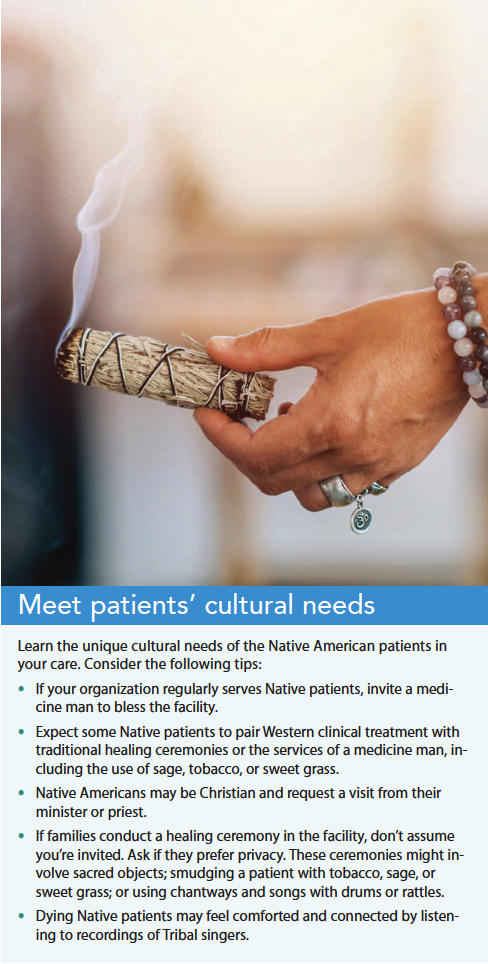

Without this understanding of an elder’s social position, healthcare providers may inadvertently offend older Indigenous patients. Consider an Apache elder who considers direct eye contact a sign of disrespect. At a non-Native facility, he might be treated by a younger physician who learned to make eye contact with patients to build rapport. The patient may feel disrespected and alienated and the physician confused when the patient doesn’t return for a follow-up appointment.
Many healthcare providers also don’t understand the modesty standard of some Native American cultures. In long-term care settings, you may find that Native women want an all-female wing and prefer female clinicians to care for female patients, with male clinicians caring for male patients.
Other traditional Native beliefs and values may differ from the etiquette and healthcare norms practiced by most Americans. Patients may prefer nurses to slow down because they view rushing as disrespectful. A Native elder’s conversation might include long pauses for reflection, and interrupting might be seen as aggressive or rude. Some patients may not report pain or want to discuss a terminal diagnosis because they believe that negative words and thoughts can hasten death. Nurses should always ask for permission before touching any sacred medicine bags, amulets, dreamcatchers, or feathers.
5 practices for better outcomes
Nearly every nurse will treat Native American patients at some point in their careers. Of the 6.7 million Native Americans in the United States today, only 22% live on reservations, and the population of elders continues to grow. It’s likely that every nurse will need to demonstrate culturally competent geriatric care for a Native American elder, even if they’re never within a hundred miles of a reservation.
Implementing the following five practices can help ensure Native elders receive compassionate care and improved outcomes.
1. Implement trauma-informed care
Trauma-informed care considers the impact of historical and generational trauma on patient health. Even a basic understanding of the genocide committed against Native Americans and the legacy of abusive forced boarding schools can help you approach Native patients with an informed perspective. Training on historical trauma can deepen your ability to provide a more culturally sensitive experience.
Build a caring nurse–patient relationship to gain the patient’s trust and help them feel physically and emotionally safe. If a patient refuses a procedure or treatment, respond with understanding rather than pressuring them into compliance. Present treatment options and collaborate with the patient and their family to develop a care plan that prioritizes their spiritual needs and wellbeing.
2. Provide the right cultural services
In the United States, 574 Tribal nations exist, each with their own unique traditions, religious beliefs, languages, and cultures. Because many beliefs and teachings are passed down orally, the solution isn’t as simple as reading a book on a local Tribe’s traditions. Instead, facilities can turn to the cultural workers found in most Tribal nations to recommend appropriate treatments and interaction standards. (See Meet patients’ cultural needs.)
3. Ask questions
Every nurse wants to offer a compassionate patient experience, but not every nurse has the right tools, knowledge, or experience to care for patients of different ethnic backgrounds. That’s understandable, and it’s why asking well-intended questions is so vital. Native families won’t consider you rude if you ask questions. Instead, it demonstrates a healthy recognition of their expertise on their background, values, and experiences. When you’re honest about the limits of your knowledge, Native patients are more likely to trust your sincerity in offering respectful and effective care.
4. Listen to patients and their families
Native Americans have a long history of being disrespected by clinicians, from having their ethnicity changed on forms to having birth practice requests ignored. Nurses should recognize that and make an effort to approach elder Native patients without judgement or bias. That includes listening to the challenges the patient and family face. Building trust and rapport in this way can lead to open and honest dialogues. Ask Native elders and their families about their preferences and then build care plans around those wishes as much as possible. When their wishes can’t be accommodated, explain why.
Don’t try to rush patient interactions or interrupt family members. Slow down and listen. You’ll create a friendlier rapport and learn more about the patient’s cultural practices and expectations.
5. Prepare for end-of-life traditions with family
When planning care toward the end of a patient’s life, remember the role of family and extended family in Native American culture. Prepare for large gatherings and a steady stream of visitors who want to pay their respects and honor the elder. Death traditions vary, so ask the family about theirs before moving the body. They may reject embalming or choose special clothing or ceremonial objects for their loved one.
Complex barriers, nuanced solutions
Everyone deserves to grow old with dignity and comfort. Just as Native American elders deserve recognition for their wisdom and experience, they deserve the same accessible resources and culturally sensitive care other American seniors take for granted. Native elders have endured a lifetime of injustice. It’s time for the healthcare profession to rise to a higher standard of care.
Whittney LaCroix is chief nursing officer at Tribal Health in Scottsdale, Arizona.
American Nurse Journal. 2023; 18(5). Doi: 10.51256/ANJ052312
References:
American Addiction Centers. Risks of alcoholism among Native Americans. September 14, 2022. americanaddictioncenters.org/alcoholism-treatment/native-americans
American Diabetes Association. Statistics About Diabetes. July 28, 2022. diabetes.org/about-us/statistics/about-diabetes
Cavazuti L, McFadden C, Amorebieta M, Salam Y. A search for truth—and children’s remains—at a former Indian boarding school. NBC News. November 16, 2022. nbcnews.com/specials/a-former-native-american-boarding-school-reckons-with-its-dark-past/index.html
Centers for Disease Control and Prevention. Cancer in American Indians and Alaska Natives in the United States. July 13, 2022. cdc.gov/cancer/dcpc/research/articles/cancer-AIAN-US.htm
Centers for Disease Control and Prevention. Suicide data and statistics. January 9, 2023. cdc.gov/suicide/suicide-data-statistics.html
Findling MG, Casey LS, Fryberg SA, et al. Discrimination in the United States: Experiences of Native Americans. Health Serv Res. 2019;54(Suppl 2):1431-41. doi:10.1111/1475-6773.13224
Mejia M. The U.S. history of Native American boarding schools. The Indigenous Foundation. theindigenousfoundation.org/articles/us-residential-schools
National Center for Health Statistics. Percentage of angina for adults aged 18 and over, United States, 2019–2021. https://wwwn.cdc.gov/NHISDataQueryTool/SHS_adult/index.html
National Indian Council on Aging. Diabetes still highest among AI/AN. January 14, 2019. nicoa.org/diabetes-still-highest-among-ai-an
National Native American Boarding School Healing Coalition. boardingschoolhealing.org
Native Hope. Native American Life Today. pages.nativehope.com/native-americans-today
Rice K. A Brief history on the forced sterilization of Indigenous peoples in the US. The Indigenous Foundation. theindigenousfoundation.org/articles/a-brief-history-on-the-forced-sterilization-of-indigenous-peoples-in-the-us
Sanders Winchester B. Dementia in Indian country. Indian Health Service. November 21, 2018. ihs.gov/newsroom/ihs-blog/november2018/dementia-in-indian-country
Thorington J. Researchers study Alzheimer’s, dementia, among Native Americans. The Daily Evergreen. September 18, 2019. dailyevergreen.com/61746/news/researchers-study-alzheimers-dementia-among-native-americans
U. S. Department of Health and Human Services. Cancer and American Indians/Alaska Natives. August 26, 2021. minorityhealth.hhs.gov/omh/browse.aspx?lvl=4&lvlid=31
Key words: Native Americans, Native American elders, compassionate care, culturally sensitive care, healthcare access, healthcare resources, healthcare disparities, historical trauma, trauma-informed care

